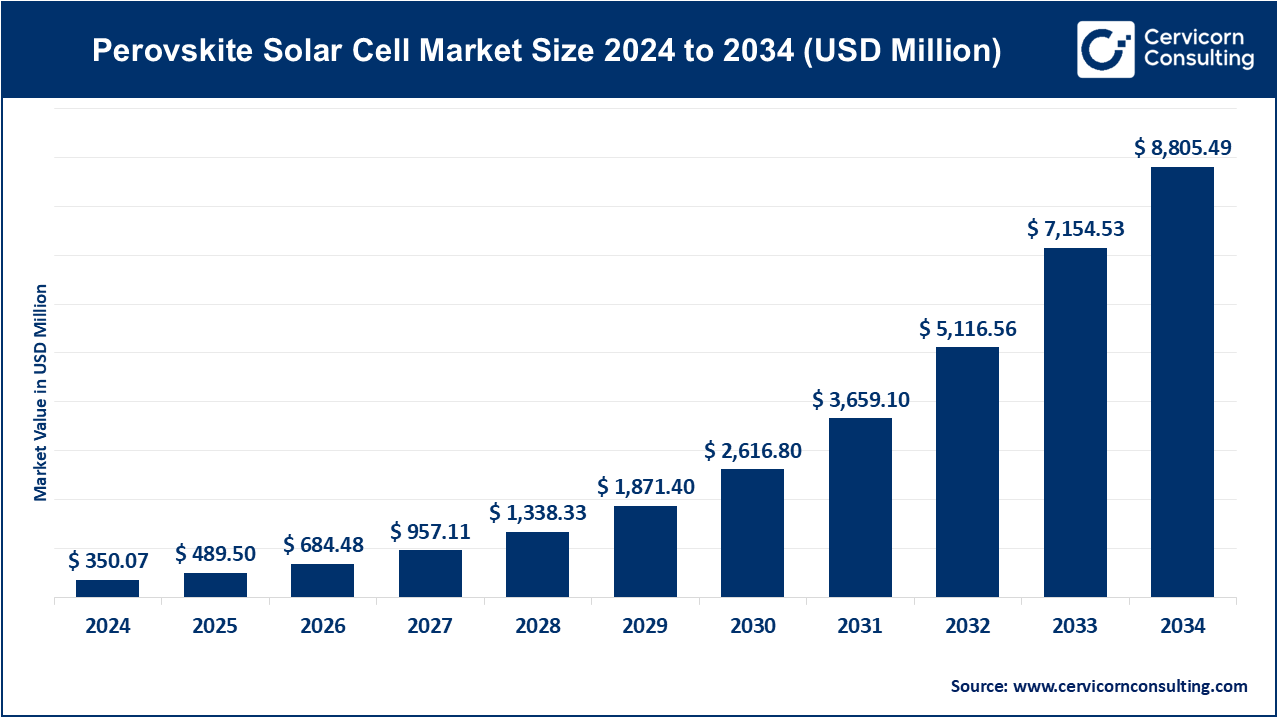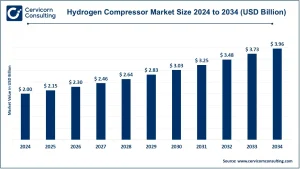Perovskite Solar Cell Market Overview
The global perovskite solar cell market is experiencing rapid expansion as it emerges as a highly efficient and cost-effective alternative to conventional silicon-based solar technologies. In 2024, the market is valued at USD 350.07 million and is forecasted to reach nearly USD 8,805.49 million by 2034, registering an impressive CAGR of 38.05% over the forecast period. This strong growth trajectory is being driven by advancements in solar technologies, surging global investments in renewable energy, and increasing government initiatives supporting carbon neutrality.
Key Market Trends
1. Technological Breakthroughs in Efficiency and Stability
Continuous R&D advancements are significantly improving the efficiency and stability of perovskite solar cells. Laboratory studies have demonstrated conversion efficiencies exceeding 25%, even surpassing some silicon counterparts. Hybrid tandem configurations (perovskite combined with silicon) are attracting attention for their ability to achieve over 30% efficiency, paving the way for large-scale commercialization.
Get a Free Sample: https://www.cervicornconsulting.com/sample/2356
2. Expansion into Flexible and Lightweight Applications
Due to their lightweight and flexible characteristics, perovskite solar cells are being utilized in diverse applications beyond standard solar panels. These include building-integrated photovoltaics (BIPV), consumer electronics, and automotive solar modules. Roll-to-roll manufacturing technologies are also being explored, which could make production more scalable and cost-efficient.
3. Policy Support and Regulatory Push
National and regional sustainability policies are providing strong support for adoption. Incentives such as tax credits, subsidies, and R&D funding in markets like the EU, U.S., China, and Japan are accelerating commercialization. For instance, the European Union’s Green Deal has earmarked substantial funding for renewable energy technologies, positioning perovskite solar cells as a strategic innovation.
4. Growing Consumer Demand for Clean Energy
With sustainability becoming a priority, consumers in advanced economies are showing preference for green energy solutions. Affordable, efficient, and easy-to-install perovskite cells are gaining traction in both residential and commercial sectors.
5. Commercialization Through Partnerships
Collaboration between startups, research institutions, and energy providers is fast-tracking commercialization. Companies such as Oxford PV and Saule Technologies are spearheading pilot-scale production while forming partnerships with utilities and the construction sector for broader deployment.
Market Drivers
-
Rising Global Renewable Energy Demand: With energy consumption increasing and climate change concerns mounting, renewables are being prioritized. The IEA projects that renewable electricity capacity additions will reach ~440 GW in 2024, strengthening demand for innovative solar technologies.
-
Cost Advantage Over Silicon: Perovskite solar cells are cheaper to manufacture due to simpler processes such as solution-based and roll-to-roll printing, making them ideal for mass-scale deployment.
-
Government Support and Investments: Policies promoting clean energy, including renewable energy mandates, grants, and R&D initiatives, are accelerating growth. The U.S. Department of Energy has already funded several perovskite development projects under its Solar Energy Technologies Office.
-
Improved Durability: Advances in encapsulation and material composition are addressing historical challenges such as moisture sensitivity, enhancing long-term performance.
-
Diverse Applications: Their adaptability in transparent, semi-transparent, and flexible designs makes perovskite cells suitable for smart windows, IoT devices, and automotive integration.
Impact of Trends and Drivers
-
Regional Insights:
-
Europe dominates research and pilot projects with strong sustainability policies.
-
Asia-Pacific (China, Japan, South Korea) is emerging as a cost-competitive manufacturing hub with ambitious solar adoption targets.
-
North America benefits from government incentives and corporate investments in renewable energy.
-
-
Segment Insights:
-
Tandem cells are expected to lead due to superior efficiency.
-
Flexible perovskite modules will gain traction in electronics and automotive markets.
-
Utility-scale projects will increasingly adopt perovskite-silicon hybrid panels for large deployments.
-
Challenges & Opportunities
-
Challenges: Issues like large-scale production, long-term stability, and toxicity linked to lead-based perovskites remain barriers.
-
Opportunities: Development of lead-free alternatives and innovations in scalable production methods present significant growth potential, enhancing competitiveness with silicon technologies.
Future Outlook
Enhanced performance, greater stability, and scalable manufacturing are expected to drive mainstream adoption in both residential and commercial markets. With global decarbonization efforts, cross-sector collaborations, and the expansion of smart energy systems, perovskite technology is poised to redefine the solar industry by offering affordable, efficient, and sustainable energy solutions.
Contact for Detailed Market Insights: https://www.cervicornconsulting.com/contact-us

